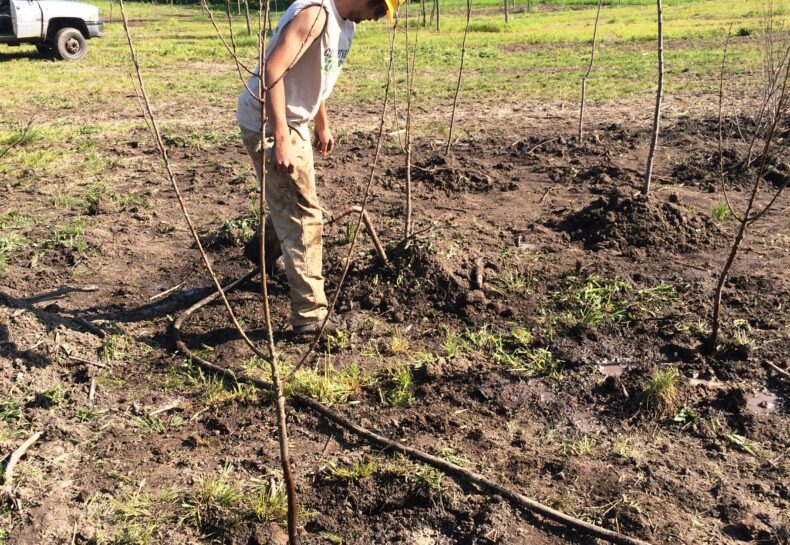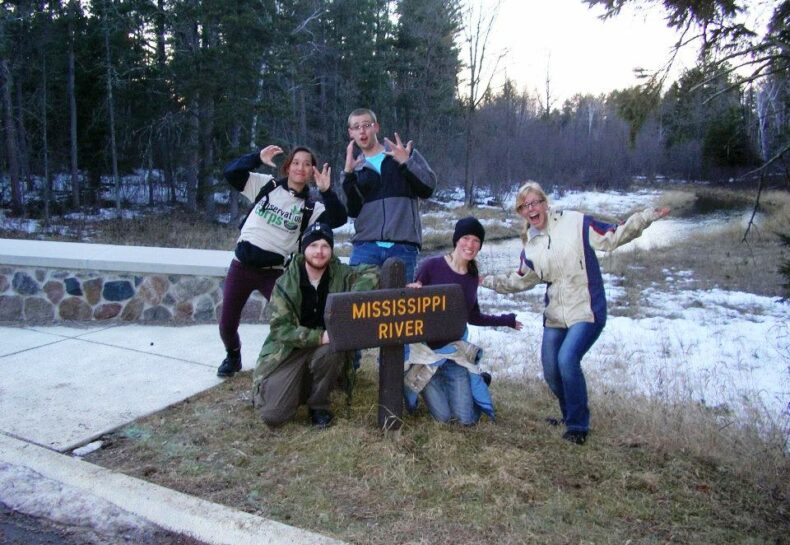Updates & Stories
Extra, extra
The 2013 Conservation Corps Minnesota & Iowa annual report is hot off the press. Read about our highlights and accomplishments online, or contact Connie to have a copy mailed to you. Read More
These feet are made for working
For the third year in a row, SmartWool supported the Corps with a generous donation of quality socks for our youth and young adult members last August. There have been many happy faces and feet when we handed them to youth and young adults participants from last fall through this summer. Thank you, SmartWool! Read More
“Tree Train!”
After what seemed to be a never-ending winter with dangerously cold temperatures and lots of snow, any sign of spring was more than welcome. Like many people, I associate spring with trees budding out and showing off their leaves. At the nursery, this sign of spring signals the start of spring harvest and planting season. Before anything can go in the ground, additional large bare root trees and shrubs have to be harvested to supplement those harvested in the past fall harvest season. The process is made very efficient through the use of one of my favorite pieces of machinery: the crawler. It has the ability to prune roots of trees and shrubs and shake off the excess dirt while two people stand on the platforms and hoist them out of the soil to pass onto the runners going back and forth to the delivery truck. Read More
Fire in North West
Some of the work we do involves wildland fire. Conservation Corps members not only help firefighters with wildfire suppression, but also help natural resource managers with prescribed burns. Part of our training includes the completion of a week-long course for an Incident Qualification Card, or Red Card. The Red Card is a certification given by the Minnesota DNR that qualifies individuals to work with fire at federal, state, county, and local agency levels.Corps members most often help with wildland fire ‘mop up,’ which is the work done after flames have been extinguished and the fire is no longer running. In the burned or ‘black’ area, firefighter doing mop up put out smoldering material and clear logs, brush, and other fuels from the edge of the burned area to prevent the fire from reigniting. Mopping up after the fire has been controlled has been my experience with wildfire as part of the North Woods crew. Read More
Laughing, joking and living it up
When you run into our crew in the woods, we are running chainsaws. We are dirty and rundown. Our muscles bulge and our faces sweat.When you run into our crew on the prairie, we are lighting fires. We are tired and covered in soot. We are carrying heavy packs and flaming torches.When you run into our crew anywhere, we are working and working hard. We are young and strong. We’re the Ottertail Crew, at your service!Sometimes, I think I love the Corps because it gives us a chance to be the people that hide in the corners of our collective childhood: the lumberjacks and firefighters, the mothers and fathers that everyone is excited to see on career day. I’ve become the adult I wanted to be, and I am cool.Then reality hits: it’s windy and raining, or it’s eighty five degrees at 10 a.m., or a saw quits on the first day of a project and I’m stuck pretending to be a mechanic. I lose track of the glamor and put my nose to the grindstone. And then we’re all grinding away, distracted and perhaps worlds away from each other in a 10 foot space. What happened? Read More
Northeast alumni toast old friends
On May 15, alumni, project hosts and supporters gathered for happy hour at Clyde Iron Works in Duluth to celebrate their Conservation Corps love. 28 attendees representing the YCC, YACC, MCC and the current Corps enjoyed appetizers, cold beverages, catching up with fellow supporters and winning door prizes. A special thanks to the Northern Pine Riders Snowmobile Club for a generous donation that made this event possible. Read More
In other NE news…
Photo: The Grand Rapids and Tower field crews on the North Country Trail in May. Working with the… Read More
YO service wraps up spring session
Photo: Dima Iresso from the YO3 crew repaired a bike during his crew’s spring service project at Cycles for Change. Read More
Blue Cross and Blue Shield of Minnesota plant seed bombs
On the sunny afternoon of May, 13 Blue Cross and Blue Shield of Minnesota employees teamed up with Conservation Corps and the City of Eagan to plant more than 100 dozen seed bombs at Patrick Eagan Park in Eagan. The Corps’ first and largest seed bomb making event took place at the Blue Cross CareFest last fall where employees made more than 70 dozen seed bombs, and other native seed balls were created by more than 200 volunteers in 2013. Seeds in the 'bombs' (which were stored over the winter) contain more than a dozen varieties of native flowers and grasses that attract honeybees and butterflies and prevent soil erosion ― perfect for the park’s native habitat. The area planted was recently treated with a prescribed burn to remove invasive species. Read More
A forest person
Have you ever been around a kid at age 3 or 4? At a certain point around this age, any vocabulary they’ve developed is completely lost and replaced with two questions: “What’s that?” and “Why?”. Those kids are my role models. Heck, to any co-workers who’ve demonstrated any bit of knowledge about anything in the forest, prairies, skies, or waters, I am one of those kids. Sorry about that, but thank you!I’ve been alive for a while. But really, 2013 was my first year alive, at least in terms of being a “forest person”. For an entire year, I spent 40+ hours among the trees and grasses and forbs of Minnesota, looking at things, hearing things, and feeling things. I learned that there are trees, plants, birds, bugs, and weather and among each of those exist many different kinds. With four seasons under my belt, I became a “forest toddler” and I decided to do it all again. Just like that kid, I want to know what kind of tree that is, and why it’s there. What kind of bird is laughing at me while I swat mosquitoes frantically? What’s that plant? And that one? And that one? When will it flower? What is that caterpillar going to turn into and which one of these plants is making me so itchy? (Poison ivy is so great! It’s like finally reaching that spot on your back and scratching, except you can get it in easily reachable places and itch that baby whenever you want! Anyway…..) Read More






